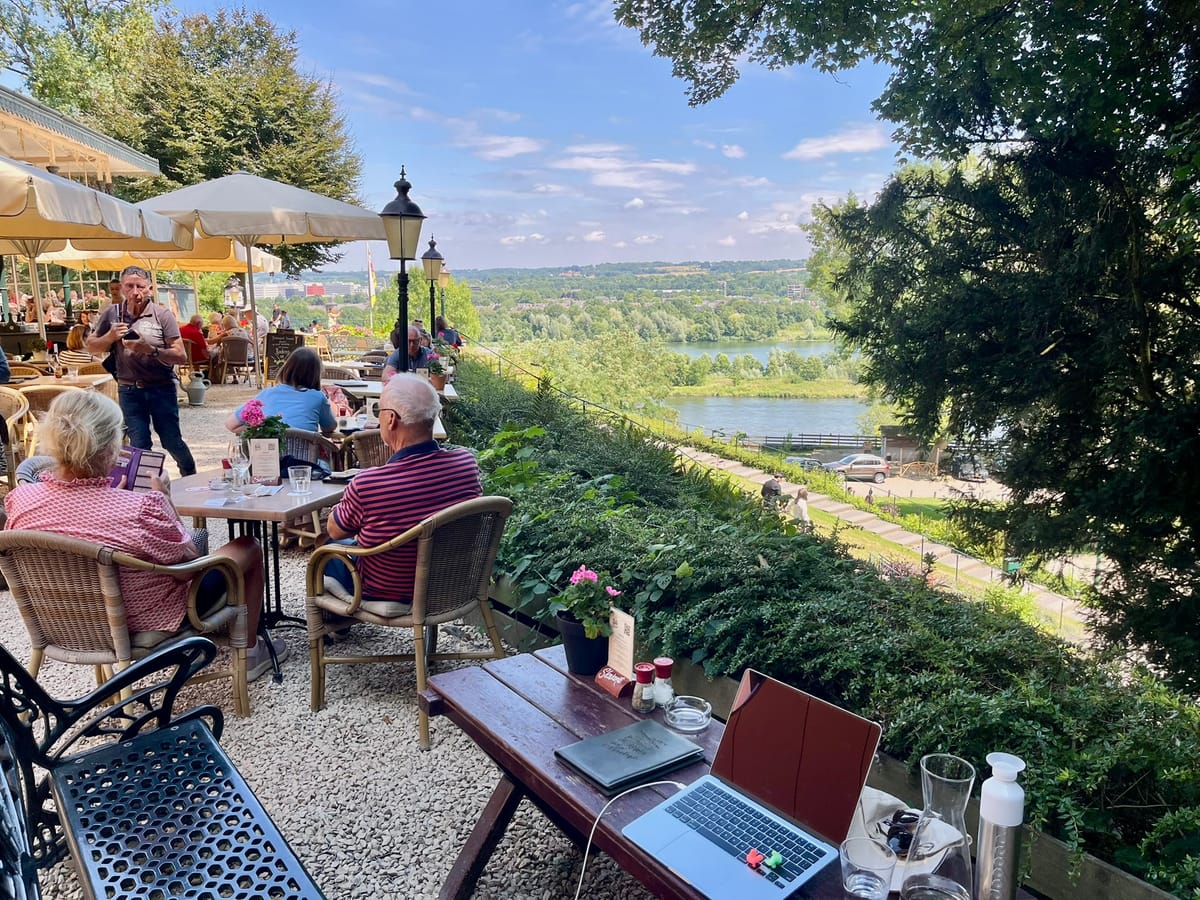Getting a Grasp of SAF
An introduction to SAF production processes

Sustainable aviation fuel (SAF), as a concept, seems simple enough to me: planes need fuel to fly, and if we keep making fuel out of stuff we drill out the ground, bad things happen. Planes and their engines are built to operate for a long time, and there will still be jet-fuel burning planes being built for decades to come. SAF molecules are almost identical to fossil-derived fuel molecules, without the increase in atmospheric CO₂. So, we need SAF!
If I am going to work with a partner in the SAF space, I need (at least) a rudimentary understanding of the different processes involved. In this newsletter, I'll take you along as I use a simple framework to assess the feasibility of the SAF production methods I've spent the last couple of weeks learning about.
The Framework
When it comes to SAF, ultimately, one metric is king: the cost per unit of abated emissions. You can imagine: a plane that needs to get from A to B, burning a certain amount of fuel in the process. How much lower will the lifecycle green house gas (GHG) emissions be using SAF, relative to fossil-derived jet fuel, and how much will that fuel cost? Divide the first number by the second, and you have the key cost per abatement metric.
There are a few key factors - I'm going with four, for the time being - that contribute to the GHG reduction and cost associated with the different processes:
- Feedstock - what phsical things, raw materials, flow into the process at the start? Different processes use different feedstocks. How much of the feedstock is already around and what does it cost? Is it possible to use a waste stream as feedstock?
- Energy/Operating Expenditure - how much electrical energy is required as part of the process? Power requirements contribute to costs, along with paying staff, maintenance etc.
- Capital Expenditure - SAF production facilities are massive, expensive machines. The cost of the facility itself is effectively spread accross every unit of fuel that is produced.
- Green House Gas Emissions - despite cutting out the fossil fuel part of the equation, there are still GHGs associated with most SAF production processes.
The Contenders
There are a few key SAF-generation processes that dominate the market. For now, I'll focus on their performance in terms of our framework, rather than getting into too much detail about the chemistry magic of how they work. Here's a table ChatGPT produced for me:
| Production Pathway | Feedstock (Availability & Type) | Energy / Operating Expenditure | Capital Expenditure (Scalable Infrastructure) | GHG Emissions (Net Lifecycle) |
|---|---|---|---|---|
| HEFA | Waste lipids & vegetable oils. Waste stream limited at scale; land-intensive crops unscalable. | Low to moderate; hydrogen demand remains significant. | Moderate; mature retrofits or modular designs possible. | Moderate (~50–70% reduction). Feedstock constraints limit full decarbonisation. |
| FT | Lignocellulosic biomass, MSW. Large theoretical availability, but land and logistics intensive. | High; energy for gasification + synthesis. Can be decarbonised. | High; complex multi-step plants, but modularity may improve. | High (~80–90%) if biomass is sustainably sourced and energy is renewable. |
| ATJ | Sugars, alcohols from cellulosic crops or industrial waste gases. Some competition with other sectors. | Moderate to high; fermentation + upgrading needs energy and water. | High; multiple processing stages. | Moderate (~60–75%) if cellulosic feedstock and renewable energy are used. |
| PtL/eSAF | Captured CO₂ + green H₂. Feedstock virtually unlimited. | Very high; depends on cheap, abundant renewable electricity. | Very high; requires DAC, electrolysis, FT units. | Very high (>90–100% net reduction) if fully renewable. Best long-term climate potential. |
| HTL | Wet biomass (sewage, algae, food/ag waste). Very promising for waste valorisation. | Moderate; heat and pressure requirements but no drying step. | Moderate to high; reactors are simpler than FT or ATJ but still industrial. | High (~80–90%) if waste feedstock is used and energy is renewable. |
Let's make sense of all that information.
The Hydrotreated Esters and Fatty Acids (HEFA) process is the workhorse of the SAF industry today. Over 95% of all SAF currently produced is made using this process. Its feedstock of used cooking oils is its biggest strength and weakness. It's relatively easy to transform the oil from Macca's frying bays into fuel to be delivered to the wing of a plane, so the costs are low. Already, though, the industry is struggling with having enough used oil to keep up with demand. Considering less than 1% of all jet fuel burned is SAF at the moment, expanding past HEFA SAF production is essential.
The Fischer-Tropsch (FT) process was designed in the 1930s and was implemented by Germany during WW2 and during the Middle East oil crisis in the '70s (among other use examples) to turn coal into oil (reference pp97&142 (use of retro SIPRI source is for you, Nada)). For SAF, we feed-in agricultural or municipal waste, rather than coal. It's tried and tested, but the need to gasify the feed, and the use of high pressures, requires a lot of energy. Power to Liquid (PtL), or eSAF is a variation of the typical FT, that uses carbon from direct air capture, or other sustainable sources, rather than a solid feed.
Alcohol to Jet (AtJ) is most popular in the US, where there is already a considerable amount of corn that is grown for the express purpose of ethanol production, mostly for cars. It turns out that growing corn to turn into fuel is a bad idea, this Real Engineering video explains in more detail. So we're going to give AtJ a pass.
Finally, we get to HTL (Hydrothermal Liquefaction), the process I'm most excited by. HTL is still yet to be certified for creating jet fuel, but that's expected to change later this year thanks (in part) to a pilot project in Queensland, Australia. Tbh reading about the project does stir some national pride. HTL is great because it can convert wet organic waste - like sewage sludge, food scraps, algae - into biocrude, without the need for energy-intensive drying. This means HTL can cost-effectively turn underutilised waste streams into high-quality jet fuel. How good.
Where to from here?
I've got two steps I want to take next, motivated by what I've encountered so far:
1. It's time to talk to some people:
Mark Kelly - The SAF Podcast has been a great resource, keeping me company on my rides to and from the office. Mark co-authored the recent Sustainable Aviation Fuel Market Outlook 2025 report from ICF and SkyNRG. There is, interestingly to me, no mention of HTL in the report, and I want to find out why! (I suspect it's due to its current lack of certification). Mark also recently finished his PhD and is now working for ICF (consultancy) in the SAF space, so I'm interested to hear where he thinks the most exciting opportunities are in the SAF industry for a soon-to-be freshly-minted Economics PhD.
Anna Liznerova - co-wrote the aforementioned SAF report, from the SkyNRG side. SkyNRG are, conveniently, based in the Netherlands, and have been dealing in SAF for over 15 years. As I understand it, they do more-or-less what I aspire to do: operate as a market facilitator. I'm interested to hear from Anna if SkyNRG already has plans for trading/negotiating feedstock deals as FT and HTL capacity comes online in the coming years. The feedstock for these processes is a significant contributing factor to the cost of the end product, and the flexibility of the processes means there’s LOTS of room for optimisation, an exciting prospect. Grid capacity, as well, will be a concern for these production facilities; they will need to draw heaps of (renewable) power from the grid, which is not as simple as just plugging in your toaster (licenses, capacity requests etc).
Anders Edling Hultgren - is the founder of Votion Biorefineries. He has patented a novel method for cleaning the crude bio-oil before the HTL process, greatly improving the efficiency of the process. HTL relies on a catalyst; having cleaner crude bio-oil (made from forestry/sewerage waste etc) means the catalyst performs better for longer. According to Votion's F6S page (LinkedIn for entrepreneurs, apparently) they are raising capital at the moment; perhaps I could be of assistance to Anders and Votion.
2. We need heeeeeaps of hydrogen
Most of the processes have some form of hydro-treatment step, where hydrogen gas is added to a carbon soup to create the longer-chain SAF molecules. It's not just SAF though, green hydrogen (when you split pure water into hydrogen and oxygen using renewable electricity) is needed for ammonia production and green steel. I just saw a video of this super cool wave power turbine thing (seriously, watch the video) that seems like a really interesting avenue for future green H2 production, but I wonder what are currently the leading G H2 production methods?
Stay tuned next time to see how my reaching-out goes, and for a lightning recap of the current state of green hydrogen.

